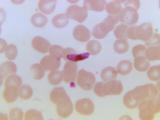Apr 1, 2009
H5N1 strikes another Egyptian youngster
Egypt's state news agency said today that a 2-year-old Egyptian boy has been hospitalized with an H5N1 avian influenza infection, Reuters reported. The country's health ministry said the boy, from Beheira governorate in northern Egypt, got sick after he had contact with infected birds. He was hospitalized and started on oseltamivir (Tamiflu) on Mar 30 after coming down with a high fever. If the World Health Organization (WHO) confirms the boy's case, the H5N1 count for Egypt will rise to 61 cases, of which 23 have been fatal.
[Apr 1 Reuters story]
Flu vaccine rated as 53% effective in Australian study
Researchers estimated seasonal influenza vaccine effectiveness over five seasons (2003-07) in Victoria, Australia, at 53%, but the number dropped to 41% when they adjusted for age-group and year. The researchers used a retrospective case-control approach with a surveillance system that yielded all patients' influenza and vaccination status, according to their report in the April issue of PLoS One. Patients who tested positive for influenza went to a WHO collaborating center for virus culture and typing. The investigators found no significant differences in vaccine effectiveness in years when the flu vaccine was well-matched to circulating strains compared with years when the match was poorer.
[April PLoS One study]
Cross-contamination suspected in tainted pistachios
Federal investigators still don't know how four different Salmonella strains contaminated bulk pistachios that were received by Kraft Foods, but a Kraft spokeswoman said company auditors who recently visited Setton Farms, the source of the nuts, found that raw and roasted nuts weren't adequately segregated, which might explain the problem, the Associated Press (AP) reported today. An official from Setton Farms also said he suspected cross-contamination. Meanwhile, Salmonella findings so far have touched off recalls of 63 pistachio products, according to the US Food and Drug Administration (FDA).
[Apr 1 AP story]
[FDA pistachio recall database]
Cases rise in sprout-linked Salmonella outbreak
A multistate Salmonella Saintpaul outbreak, which might be linked to contaminated sprouts, has grown to 121 cases in Nebraska, Iowa, South Dakota, Kansas, and Colorado, the AP reported yesterday. The case count was listed in a lawsuit against an Omaha, Neb., sprout company, SunSprout Enterprises, by a Nebraska man. So far, investigators have not isolated the outbreak strain from any sprout samples.
Prions found in antler velvet of elk with chronic wasting disease
Infectious prion proteins are found in the antler velvet of elk that have chronic wasting disease (CWD), as revealed by tests involving CWD-susceptible transgenic mice, according to a report in Emerging Infectious Diseases (EID). The authors say the finding suggests that antler velvet, which is shed annually, may play a role in CWD transmission. Given the market for antler velvet in traditional Asian medicine, the finding also indicates that people who consume the material as a nutritional supplement are at risk for exposure to prions. CWD is a brain disease of deer and elk that resembles bovine spongiform encephalopathy, or mad cow disease.
[EID report]
Researchers launch online vector database
To ease the development of risk maps and other assessments, an international group of researchers has developed a Web-based, publicly accessible Disease Vector Database. The purpose is to gather and display data on the geographic distribution of infectious disease vectors and reservoirs, according to a report in the March issue of PLoS Neglected Tropical Diseases. The database, housed at the University of Texas at Austin, currently contains records for dengue and malaria vectors, as well as Chagas disease and leishmaniasis vectors and reservoirs.
[March PLoS Negl Trop Dis report]
Comparing three online outbreak-monitoring systems
A report in EID compares three online systems that collect and process information about disease outbreaks and other public health threats from a wide range of electronic sources. The systems are GPHIN, which monitors media information and provides reports to paying subscribers; HealthMap, which collects and maps disease outbreak information from media and nonmedia sources; and EpiSPIDER, which was designed as a visual supplement to the disease reports from ProMED-mail. The EID article, written by the inventors of the three systems, says they are complementary because they monitor different kinds of data, rely on varying levels of automation and human analysis, and distribute distinct information. "Future development should focus on linking these systems more closely to public health practitioners in the field and establishing collective networks for alert verification and dissemination," the report states.
[EID report]




















